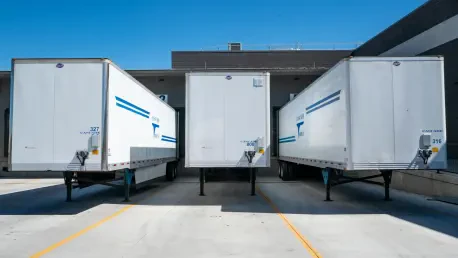With a wealth of experience in strategic management and operations, Marco Gaietti has been instrumental in navigating complex business landscapes. In this interview, he shares insights into the creation and impact of the innovative ContainerWheels 2-in-1 system, a product poised to revolutionize container handling.
Can you share the journey of developing the ContainerWheels 2-in-1 system, from the initial idea to its current patent status in 45 countries?
The inception of the ContainerWheels 2-in-1 was quite organic. We started with a simple concept: to make container transport more accessible and less reliant on bulky machinery. Over two years, we refined this idea, tackling each challenge until we had a robust product. Achieving patent status in 45 countries was a huge milestone, reflecting the universal applicability and potential of our system.
What were the main challenges you faced during the two-year development and testing phase of the ContainerWheels system?
One of the significant hurdles was designing a mechanism that could be both compact and durable for diverse conditions. Testing in various environments and ensuring the system remained easy to use while maintaining safety standards required numerous iterations. Each challenge taught us something new, ultimately strengthening the final product.
Could you explain how the ContainerWheels 2-in-1 system works in more detail, especially its lifting and towing mechanism?
The system employs a straightforward yet efficient design. It features two galvanized modules with solid dual wheels and a manual crank-lift mechanism. These modules slide into the container’s forklift pockets, allowing you to lift the container about 15 cm off the ground. Once raised, the container can be easily towed by a range of vehicles, including forklifts and tractors.
What are the specific advantages of using the ContainerWheels 2-in-1 system compared to traditional container handling methods?
The primary advantage is its versatility and simplicity. It eliminates the need for heavy machinery, making operations quicker and more adaptable, particularly in spaces where maneuverability is restricted. This system also significantly reduces costs associated with machinery rental and labor.
How does the system ensure safety while lifting and transporting heavy loads?
Safety was a top priority during development. The dual-wheeled modules and manual crank-lift mechanism are designed to distribute weight evenly, preventing tipping. Components are galvanized for durability, ensuring they withstand rough handling and uneven terrains without compromising on security.
You mentioned that the system is designed for uneven terrain. Can you explain the technology or features that allow it to function effectively in such conditions?
The robust construction of the modules and the solid wheels ensure stability, even on uneven ground. The wheels absorb shocks and provide smooth transport, while the overall design keeps the container balanced, preventing unwanted movement during transit.
What feedback have you received from initial users or testers of the ContainerWheels 2-in-1 system?
Feedback has been overwhelmingly positive. Many users appreciate the system’s ease of use and efficiency. Initial testers have highlighted how much faster and simpler container handling has become, especially in tight or less accessible areas.
Can you discuss the decision to create two models with 10 and 20-ton capacity? How did you determine the need for these specific load capacities?
These capacities were chosen based on industry needs. During our research, it became evident that a significant number of companies handle containers within these weight ranges. Offering two models allows us to cater to a wider range of operations, providing flexibility and choice for our clients.
How do you envision the ContainerWheels 2-in-1 impacting logistics and operations for companies worldwide?
I believe it will transform logistics by democratizing container handling. Companies that previously had to invest in heavy equipment can now transport containers with ease, enabling greater operational efficiency and opening new possibilities for businesses of all sizes globally.
Are there any specific industries or sectors that you believe will benefit the most from this system?
Industries such as construction, recycling, and warehousing stand to gain the most. These sectors often deal with intricate logistics, moving containers between sites or within facilities. Our system provides the agility they need without the overhead of traditional equipment.
With the introduction of the ContainerWheels 2-in-1 system, do you foresee any potential developments or improvements in the near future?
We’re always exploring possibilities for enhancement. Future developments may include automation features or tech integrations that further streamline operations, making the system even more intuitive and efficient.
In terms of maintenance, what are the requirements for keeping the ContainerWheels system in optimal condition?
The system is relatively low maintenance. Regular inspections and basic care, such as greasing the mechanical parts and checking the wheel conditions, should suffice. Its galvanized components are designed to withstand harsh conditions, minimizing maintenance needs.
Can you describe any unexpected benefits or uses of the ContainerWheels system that were discovered during its development or testing?
Interestingly, some users found the system useful beyond container transport. It has been employed in moving large equipment pieces and modular structures, showcasing its adaptability and potential for various applications we hadn’t initially considered.
How do you plan to market and distribute the ContainerWheels 2-in-1 system to international users?
We are focusing on establishing partnerships with distributors worldwide to ensure accessibility. Additionally, attending industry trade shows and engaging with potential clientele through targeted online marketing strategies will play a crucial role in our outreach.
What are your long-term goals for Wee.no in terms of innovation and product development in the logistics sector?
Our vision is to continually push the boundaries of what’s possible in logistics. We aim to develop products that simplify operations, reduce costs, and are eco-friendly—ultimately reshaping the landscape of global transportation solutions.
What is your forecast for the logistics industry’s future?
The future is all about integration and automation. We’ll see more systems that communicate seamlessly with each other, providing real-time data and insights. This evolution will lead to smarter and more sustainable logistics operations, setting new benchmarks for efficiency and environmental responsibility.









